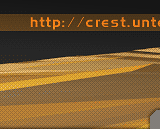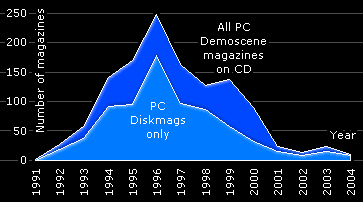


 |
 |
 |
| home | news | scene | reports | diskmag pack | new zealand | down | links | about |
Small Diskmag-Pack-FAQ
When was the Diskmag-CD created? It was 1998 when I (Thiemo Maettig, alias "mados") first developed a strong interest in the burgeoning of so called diskette-magazines, it was also when I started to collect them. Inspired by the German diskmag "Cream", which actually reached me on a diskette and that seemed to me as a perfect assemblage of text, image and music, when I had the idea to make my diskmag collection accessible to other people. Titled as "DiskMag-Pack" I started to realise the project in 1999; since it was the period when CD-ROM became highly accessible and within the reach of all.Together with other active demo scene members such as Adok (publisher of the Hugi magazine) or Coctail (at this time publisher of Cream) it was possible to complete this collection quite fast.
Is the diskmag collection on the "DiskMag-CD" up to date?
To this date it is an evident intension of my concept to offer an up-to-date CD. With regard to this there was never a specific creation date; rather the CD was rather continuously "fostered". After a few months an assemblage of diskmag-descriptions, written by myself, it was then translated into English and added to the CD. The CD »DiskMag-Pack« was published from 1999-2004 and actually missed the peak of the diskmag culture, which was reached in 1996, by some years. However, this was the perfect moment to release a diskmag archive burned on a CD and which definitely includes all evident highlights that were published in previous years.  Since at the end of 2004 the CD is offered as »DiskMag-Pack 2004« the collection is not updated any more, although there are still a few very high quality diskmags which are published.
Which criterions were decisive for adding a diskmag to the collection?
At the beginning I just collected diskmags written in German. It was not possible to fill one CD just with them hence I added all popular English and a subjective but representative selection of digital magazines published in other languages such as Polish, Russian, etc. Diskmags from other platforms, like the C64 platform and different Amiga platforms are not included in »DiskMag-Pack« collection. Therefore, the CD gives a distorted picture of the demoscene: the PC platform was the last one which adapted diskmags to spread latest news through the scene members. The publication form diskmag has its origin around 1988 - 1989 and was primary used within the Amiga 500 and C64 scene. The demoscene platform pouet offers an almost complete overview.
Does this CD include the most important diskmags of the whole demoscene which were published within 1991-2004?
The CD collection focuses on diskmags written in the German language. However, it also includes some examples from the quite remarkable offer of diskmags on offer published in other languages such as Polish, or Russian which seemed to be particularly remarkable from a visual and acoustical point of view. A CD does not offer a lot of memory space. At least three CDs are necessary in order to make a collection of all PC diskmags that have ever been published. Summarizing; the CD »DiskMag-Pack« offers a comprehensive overview of diskmags published in German and English within the PC demoscene as well as a brief introduction to a subjective selection of examples from the national scenes.
Which are the most important, most popular diskmags that have a strong impact on the demoscene?
The most important diskmags are the most durable ones: Hugi (place of residence of the editor is Austria) and PAiN (place of residence of the editor is Switzerland). Both have released more than 50 different publications thus far. The differences between both magazines are not identifiable for people who are not involved in the demoscene. Active demosceners distinguish between the more popular oriented Hugi and the diskmag Pain which focus on the hard core demosceners. Imphobia, the "primal diskmag" was above all precursory for the whole PC-Scene. Further the two controversial digital zines "Shine" and "Demojournal" are mentioned as pioneering representatives of newsletter formats.
Which are the most important German diskmags?
"Blackmail" (target group: coder) and "Hot-Mag" together with "Cream" were the most significant diskmags in the German demoscene. With the abandonment of WildMag at the end of 2001, the last diskmag of the German-speaking demoscene disappeared. InterNet and the increasing internationalization were not able to replace this publication form completely however, the publication of current diskmags requires much more personal enthusiasm than before the rise of new communication technologies.
Which diskmags that are mentioned on the CD are still published?
Hugi and »Static Line« is not a diskmag but a publication that arose out from the demoscene. However, after one year no further editions have yet been produced. »Scene Zine« is not a real diskmag but an online newsletter which is still published. A good overview about currently active diskmags is available through the internet portal »Pouet«. Above all, Polish and Russian demosceners are still engaged in diskmag creation.
Where do I get diskmags from?
A large selection of diskmags which are also available on CD can be downloaded from Scene.org. However, all descriptions and screenshots are only available on the CD. (Thanks to Regina Webhofer for the english translation - Crest) |